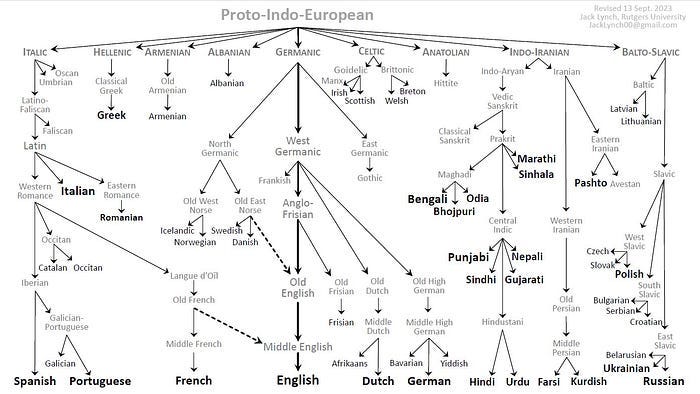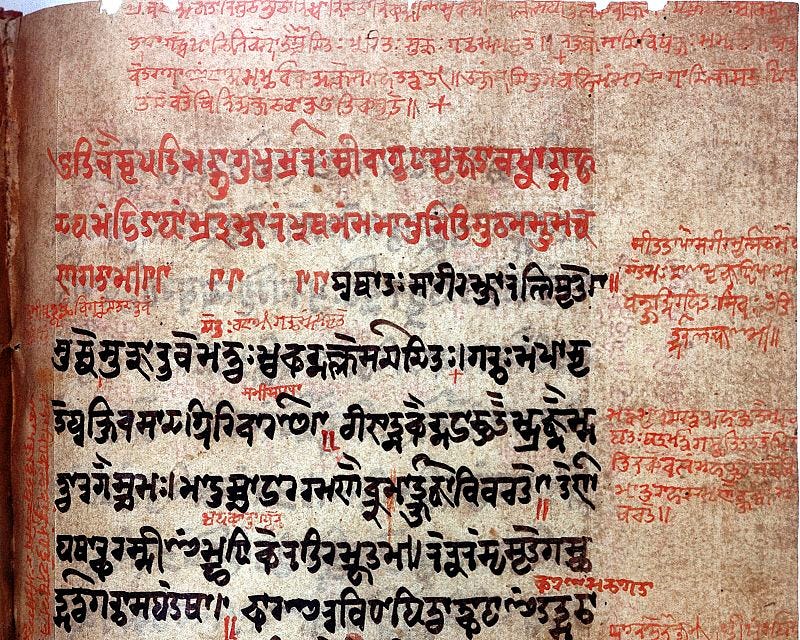How Old is Sanskrit?
Proposing a timeline for Sanskrit’s origins based on its earliest texts, historical records, horse genetics, and archaeology
Sanskrit is the oldest language still spoken. About 25,000 people in India consider it their first language, and as of 2011, the country had another two million Sanskrit speakers. The United States has the highest number of higher education institutes that offer Sanskrit courses (36), followed by India (15), Germany (14), and Italy (12).
But how old is the language?
The controversy over Sanskrit's antiquity has generated two extreme views. Depending on who you ask, opinions on the language’s age range from 22,000 to 2,000 years ago.
To date, we must examine the oldest texts and written documents in a language. The earliest scriptures in Sanskrit, the Vedas, were composed orally and passed down through generations before they were written, making dating them challenging. However, the Vedas contain clues that help linguists and archaeologists to propose a timeline for their hymns.
Let us look at Sanskrit’s earliest written evidence and suggest possible dates for the oldest Sanskrit text, the Rigveda. We’ll begin with the first known proof of written Sanskrit.
Where was it found?
Hint: Not in the Indian subcontinent!
Reminder: By choosing a paid membership (just $5 a month or $50 annually), you're helping amplify voices that history books too often overlook. Your support means these stories get the attention they deserve.
You’ll gain access to tons of members-only content👇
Full-length deep dives into untold stories, like this one: no paywalls, no cuts.
The entire archive of extraordinary tales from the Ice Age to the Fall of the Mongol Empire, the hottest archaeological finds, and the appetizing history of food.
Early access to special editions, be the first to dive in.
Join lively discussions in members-only posts and subscriber chats (there’s one for this post, at the end!).
Origins of written Sanskrit: The earliest inscriptions

Sanskrit is part of the Indo-European language family, which includes English, German, French, Persian, Russian, Lithuanian, Latin, and Greek, as well as extinct languages such as Hittite and Tocharian. The Indo-European languages share many similar words. They are thought to have descended from a common ancestral language known as proto-Indo-European (PIE), spoken between 4500 and 2500 BC.
A 2023 study by linguist Paul Heggarty and his colleagues at the Max Planck Institute analyzed a database of 109 modern and 52 historical Indo-European languages and found that PIE was older than previous estimates, dating it to 8000 years before present, around 6100 BC.
Sanskrit is a member of the Indo-Iranian branch of the Indo-European language family. Under this group, Sanskrit, Hindi, Bengali, Gujarati, Urdu, and several other Indian subcontinental languages are categorized as Indo-Aryan or Indic. Sanskrit, Prakrit, and Pali were the lingua franca of ancient India. These languages were written in the Brahmi or Kharoshti script.
The Vedas are the first Sanskrit texts and the holy scriptures of Hinduism. The language used to compose them is Vedic Sanskrit, which predates Classical Sanskrit by at least a millennium. Classical Sanskrit is currently the prevalent form of Sanskrit, and its grammar was established between the 6th and 4th centuries BC by a scholar named Panini.
Those who argue that Sanskrit can’t be more than two thousand years old point out that the first examples of written Sanskrit date back to the first century BC, namely the Ayodhya Inscription of King Dhana and the Hathibada-Ghosundi inscriptions.
In contrast, the rock edicts of Ashoka, which date from the third century BC, are considered India’s first written inscriptions. Emperor Ashoka of the Mauryan Empire (322–184 BC) used the rock edicts to document his reign and code of conduct for his citizens. The language was Prakrit, written in Brahmi, Kharoshti, Greek, and Aramaic scripts.
Thus, the absence of written evidence to support Sanskrit’s antiquity suggests that Sanskrit was more recent than Indian languages such as Prakrit and Tamil. We can refute the “Sanskrit was not that old” theory by presenting writings before Ashoka's rock edicts.
Surprisingly, the first recorded evidence of Sanskrit comes from Syria, not India.
Keep reading with a 7-day free trial
Subscribe to Forgotten Footprints to keep reading this post and get 7 days of free access to the full post archives.


